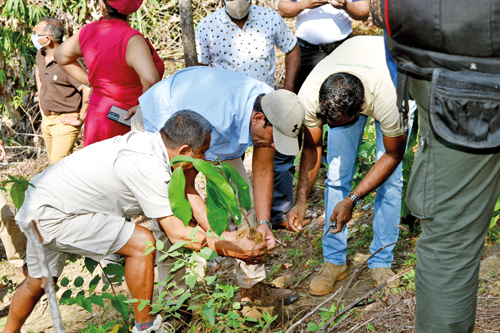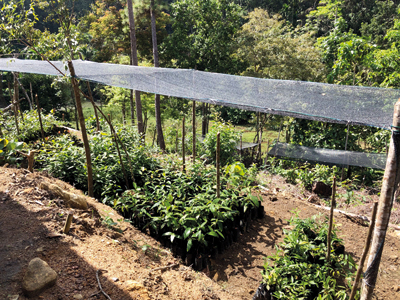Suduwelipotha: Ruk Rakaganno on a reforesting mission in Sinharaja

JKH’s Suresh Rajendra (centre) planting a sapling at the site
When Ruk Rakaganno was founded in 1975 by a group of concerned naturalists including Irangani Serasinghe, Nihal Fernando, Laki Senanayake, Lyn de Alwis, Kamini Meedeniya- Vitarana and Vere de Mel, their immediate mission was to battle the Canadian plywood factory at Kosgoda fed by wood felled from Sinharaja used to manufacture tea chests.
The lobbying had effect and Ruk Rakaganno was to grow over 45 years, its shade beneficent to an island flora as precious as it is vulnerable.
Ruk Rakaganno this year has come back to Sinharaja, with the Cinnamon Rainforest Restoration Project, done with John Keells Holdings and the Forest Department.
The forest in Suduwelipotha, around 24 hectares, was originally part of primeval Sinharaja, but was later felled and planted with Caribbean pines as a commercial crop by the Forest Department.
Later attempts by the department to reforest the land were unsuccessful and invasive plants took over the beautiful site in Kalawana.
With the Sam Popham arboretum, that shady forest in Dambulla where an English planter here built a refuge, no longer in their care, Ruk Rakaganno was looking for a similar place.

GPS image of the reforestation area
It was the vision of the late Kamini Meedeniya-Vitarana, former president of Ruk Raks to reforest Suduwelipotha, not as Sam Popham did – allowing the forest to regenerate, but as a scientific, stratified regrowth that will raise a natural rainforest with the interplay of layers.
Soil erosion does not happen in a rainforest because rain does not directly hit the ground given the layers- and it is important to recreate the same layers.
It was Vimukthi Weeratunga–project lead at John Keells Holdings –who breathed life into Kamini’s dream. He made the proposal and was instrumental in obtaining permission from the Forest Department, says Dushy Perera, president of Ruk Rakaganno. Vimukthi also covered all the technical aspects.
A number of scientists were involved, among them Prof. Siril Wijesundara, a former director of the Peradeniya Botanic Gardens, who made the stratification plan and also advised the project.
Prof. Mayuri Wijesinghe of Colombo University will be researching on the forest while a doctoral student Nimashi Fernando will use the project to pitch two methods of forest restoration, to gauge which can be more effective.
For three years since planting, she will study different types of plots- one totally cleared of invasive species; replanted with both pioneers and mid-sucessional forest species; the other replanted first with pioneer species followed by mid-successional forest species after a lapse of 18 months. More than 13,000 plants will go to form the forest. With a southern phase and a northern phase, the forest is made up of nine blocks.
The findings, says Prof. Wijesinghe, will be valuable for enhancing the success of future restoration programmes in the wet zone of Sri Lanka.
The only paid employee in the project is site manager Rohan Pandipperuma.
Involvement with the community is crucial for the success of a project of this nature.

Feeding the forest: The plant nursery
Sixteen community members were chosen and given polybags and guidelines to create satellite nurseries. Each plant is bought from them at Rupees 40. This is apart from Ruk Rakaganno’s own nursery which has 32 species of forest plants and those bought from the Forest Department and a forest nursery at Hiyare, Galle.
A sound relationship has been established with the community, and John Keells has upgraded sanitary facilities within the village.
Suduwelipotha has only 72 species of birds against the 154 within the Sinharaja. Within 10 years however John Keells with Ruk Raks hope to increase the biodiversity up to 50% of that of Sinharaja.
Along the boundaries kitul and arecanut will be planted so the community can have an extra income.
The main force behind the project, Vimukthi Weeratunga, said that the project is a long-term one. The southwest of the island is important because it is biodiversity- richer than anywhere else in the country.
While it may seem a small patch in the wet zone it is, in fact, a great achievement given the fauna and flora it is going to bring back, Vimukthi says
Present at the launch of the project last Monday were Suresh Rajendra, President of the Leisure Group, John Keells Holdings and Kamini’s children – Ranil and Menika.
Searching for an ideal partner? Find your soul mate on Hitad.lk, Sri Lanka's favourite marriage proposals page. With Hitad.lk matrimonial advertisements you have access to thousands of ads from potential suitors who are looking for someone just like you.


